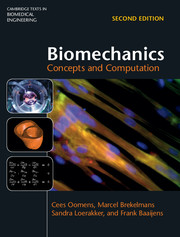Book contents
- Frontmatter
- Contents
- About the Cover
- Preface to the First Edition
- Preface to the Second Edition
- 1 Vector and Tensor Calculus
- 2 The Concepts of Force and Moment
- 3 Static Equilibrium
- 4 The Mechanical Behaviour of Fibres
- 5 Fibres: Time-Dependent Behaviour
- 6 Analysis of a One-Dimensional Continuous Elastic Medium
- 7 Biological Materials and Continuum Mechanics
- 8 Stress in Three-Dimensional Continuous Media
- 9 Motion: Time as an Extra Dimension
- 10 Deformation and Rotation, Deformation Rate and Spin
- 11 Local Balance of Mass, Momentum and Energy
- 12 Constitutive Modelling of Solids and Fluids
- 13 Solution Strategies for Solid and Fluid Mechanics Problems
- 14 Solution of the One-Dimensional Diffusion Equation by Means of the Finite Element Method
- 15 Solution of the One-Dimensional Convection–Diffusion Equation by Means of the Finite Element Method
- 16 Solution of the Three-Dimensional Convection–Diffusion Equation by Means of the Finite Element Method
- 17 Shape Functions and Numerical Integration
- 18 Infinitesimal Strain Elasticity Problems
- References
- Index
Preface to the Second Edition
Published online by Cambridge University Press: 02 February 2018
- Frontmatter
- Contents
- About the Cover
- Preface to the First Edition
- Preface to the Second Edition
- 1 Vector and Tensor Calculus
- 2 The Concepts of Force and Moment
- 3 Static Equilibrium
- 4 The Mechanical Behaviour of Fibres
- 5 Fibres: Time-Dependent Behaviour
- 6 Analysis of a One-Dimensional Continuous Elastic Medium
- 7 Biological Materials and Continuum Mechanics
- 8 Stress in Three-Dimensional Continuous Media
- 9 Motion: Time as an Extra Dimension
- 10 Deformation and Rotation, Deformation Rate and Spin
- 11 Local Balance of Mass, Momentum and Energy
- 12 Constitutive Modelling of Solids and Fluids
- 13 Solution Strategies for Solid and Fluid Mechanics Problems
- 14 Solution of the One-Dimensional Diffusion Equation by Means of the Finite Element Method
- 15 Solution of the One-Dimensional Convection–Diffusion Equation by Means of the Finite Element Method
- 16 Solution of the Three-Dimensional Convection–Diffusion Equation by Means of the Finite Element Method
- 17 Shape Functions and Numerical Integration
- 18 Infinitesimal Strain Elasticity Problems
- References
- Index
Summary
Since 2009, when this book was published for the first time, we have been using it in our Biomechanics courses in the educational programme Biomedical Engineering, giving us hands-on experience with the book and the exercises. When we were investigating ideas for a second edition, we found that external reviewers were primarily asking for more examples and exercises, concurring with our own thoughts on the book. Over the years, we have assembled quite a number of examples that were often used to animate the lectures and to illustrate the theory in biomedical applications. At the same time, the number of available exercises increased considerably. Eventually, adding many of these examples and increasing the number of exercises are the most significant changes in the second edition. The major changes in the text are:
• Mathematical preliminaries are now concentrated in Chapter 1 and no longer spread over different chapters.
• At some points in the original text, explanations were terse and too concise for students. Based on our experiences over the past eight years, we have extended the text at a number of points and, most importantly, added the earlier mentioned new examples. The biggest change is in Chapter 12, including a separate section on material frame indifference of constitutive equations and a more extensive treatment of hyperelastic materials.
The objectives of the book did not change. It is still meant to be a basic training in mechanics, appropriate for our candidate biomedical engineers at Bachelor level, starting with the basic concepts of mechanics and ending with numerical solution procedures. This book differs from most books on biomechanics, which are usually aimed at students with already considerable knowledge in continuum mechanics and wishing to enter the field of biomechanics. Consequently, those books pay great attention to biology and physiology. In contrast, we assume that students start at a very basic level in terms of mechanics, but already have substantial physiological and biological background knowledge.
- Type
- Chapter
- Information
- BiomechanicsConcepts and Computation, pp. xvii - xviiiPublisher: Cambridge University PressPrint publication year: 2018

